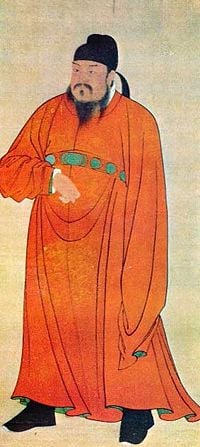Li Yuan
Emperor Gaozu of Tang China (566 - June 25, 635 C.E.), born Li Yuan, was the founder of the Tang dynasty of China, and the first emperor of this dynasty from 618 to 626. Under the shortlived Sui dynasty, Li Yuan was the governor in the area of modern-day Shanxi province, and was based in Taiyuan, Shanxi. The Dynasty which he founded would rule China for 300 years, and would considerably expand its territory. Not until the eighteenth century would China rule as great an expanse. The success of the Tang dynasty lies in the imperial examination system which it intoroduced in order to ensure that those with talent administered China. Some commentators claim that Chinese culture reached its zenth under the Tang.[1]. Li Yuan retired as emperor, handing over power to his son.
Establishment of the Tang Dynasty
In 615, Li Yuan was assigned to garrison Lunghsi. He gained much experience by dealing with the Göktürks of the north and was able to pacify them. Li Yuan was also able to gather support from these successes and, with the disintergration of the Sui dynasty in July of 617, Li Yuan—urged on by his second son Li Shimin (later Taizong emperor)—rose in rebellion. Using the title of "Great Chancellor", Li Yuan installed a puppet child emperor, Emperor Gong, but eventually removed him altogether and established the Tang Dynasty in 618. Li Yuan concentrated on unifying China. He was a wise ruler, lowering taxes and also reforming the harsh legal system.
Reign as Emperor
Li Yuan's reign was concentrated on uniting the empire under the Tang. Aided by his son, Li Shimin, he defeated all the other contenders, including Li Gui, Dou Jiande, Wang Shichong, Xue Ju, and Liu Wuzhou. By 628, the Tang Dynasty had succeeded in uniting all of China. On the homefront, Li Yuan recognized the early successes forged by the Sui dynasty and strived to emulate most of its policies, including the equal distribution of land amongst its people, and he also lowered taxes. He abandoned the harsh system of law set about during the Sui dynasty as well as reforming the judicial system. These acts of reform paved the way for the reign of Emperor Taizong, which ultimately pushed Tang China to the height of its power.
Li Yuan abdicated in 626 in favor of his son, Taizong emperor after the Xuan Wu Gate incident when Taizong had to kill his two immoral brothers who were attempting to usurp the throne. Li Yuan lived on as "Grand Emperor" (Taishang Huang) until his death in 635.
Legacy
Li Yuan's legacy was a unified China with secure borders. His heirs would expand China's territory and continue to centralize authority, also establishing an efficient communication system that helped to govern the empire. However, towards the end of its 300 years' rule, the dynasty became corrupt. Li Yuan's concent for the welfare of the peasant majority was replaced by indifference and a peasant uprising in 875 directly contributed to the dynasty's collapse[2].
Notes
- ↑ Tang Dynasty, TravelChinaGuide, Retrieved April 16, 2007. This article states that "The Tang Empire founded by the Li family achieved glory unprecedented in Chinese history
- ↑ Ibid
ReferencesISBN links support NWE through referral fees
- Gascoigne, Bamber. The Dynasties of China: A History. New York: Carroll & Graf, 2003. ISBN 9780786712199
- Hansen, Valerie. The Open Empire: A History of China to 1600. New York: W. W. Norton & Company, 2000. ISBN 9780393973747
- Huang, Xinya. Li Yuan- The First Emperor of the Tang Dynasty. ('Tang gao zu Li yuan', Chinese langauge). Taibei: Zheng Zhan, 1998. ISBN 9789578317161
- Scarpari, Maurizio. Ancient China : Chinese Civilization From Its Origins To The Tang Dynasty. New York: Barnes & Noble, 2006. ISBN 9780760783795
Credits
New World Encyclopedia writers and editors rewrote and completed the Wikipedia article in accordance with New World Encyclopedia standards. This article abides by terms of the Creative Commons CC-by-sa 3.0 License (CC-by-sa), which may be used and disseminated with proper attribution. Credit is due under the terms of this license that can reference both the New World Encyclopedia contributors and the selfless volunteer contributors of the Wikimedia Foundation. To cite this article click here for a list of acceptable citing formats.The history of earlier contributions by wikipedians is accessible to researchers here:
The history of this article since it was imported to New World Encyclopedia:
Note: Some restrictions may apply to use of individual images which are separately licensed.
